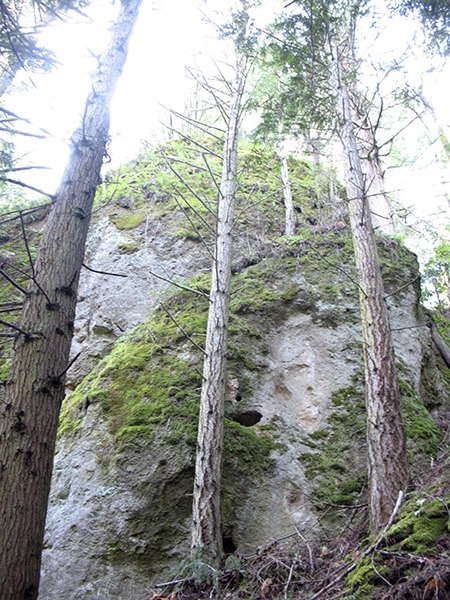For the S’Klallam people, Tamanowas Rock in Chimacum is hallowed ground. Used by Native people since time immemorial for spiritual vision quests, the rock is a unique geological formation – an immense monolith with caves, crevices and cliffs, formed 43 million years ago.
During the past two years, Tribe navigated a process to nominate and have Tamanowas Rock listed on the Washington State Heritage Register of Historic Places.
The process began with an application to the National Park Service for a Historic Preservation grant entitled Tamanowas Rock: Documenting a Sacred Site.
That grant funding enabled Cultural Resources Specialist Gideon Cauffman to research, survey and map the site, and complete an eligibility application for the State Heritage Register, the first step before moving to the National Register.
In May, the Governor’s Advisory Council on Historic Preservation recognized Tamanowas Rock on the Washington Heritage Register of Historic Places, stating in a letter from State Historic Preservation Officer Allyson Brooks, Ph.D, to the Tribe that “Tamanowas Rock, at Milepost 1, Anderson Lake Road Chimacum [has] been listed in the Washington State Heritage Register, where it joins over 1,800 other historic and culturally significant properties which have been recognized for their significant contributions to Washington’s heritage.”
The letter continues: “Having a property listed … is an honor. The benefits of State and National Register listing include potential tax credits, property tax deductions and code waivers to protect the integrity of the resource.”
In addition, the listing assures protective review of a property if a federal or state action has the potential to adversely effect to the property’s historic values.
Immediately following their vote to list Tamanowas Rock in the State Heritage Register, the Advisory Council subsequently voted 8-0 to forward the nomination to the National Register of Historic Places. That nominate was sent to the Keeper of the National Register in Washington D.C. in June.
Since the early 1990’s, the S’Klallam/Klallam Tribes and the local community have worked to save the Tamanowas Rock property from development.
A coalition of Washington State Parks, Jamestown S’Klallam Tribe, and Jefferson Land Trust worked together to negotiate and eventually purchase the property for permanent protection between 2009-2012.
The property is now owned by the Jamestown S’Klallam Tribe, and Jefferson Land Trust holds a permanent conservation easement on the property. The conservation easement permanently protects the property’s wildlife habitat, productive forest, scenic and open space qualities, and other natural values.
While available for limited public access, the Tamanowas Rock Sanctuary is not an extension of Anderson Lake State Park; it is a sanctuary, privately owned by the Jamestown S’Klallam Tribe.
One of the Tribe’s most important goals is protecting this hallowed ground from any actions that might be considered disrespectful to its culture or damaging to Tamanowas Rock. A list of allowed, conditional and prohibited activities is posted at the site and available in a Tribally-produced brochure.
This is the third traditional cultural place in Washington State nominated to the National Register. The other two are Snoqualmie Falls and Mount Saint Helens. Further, this is the 18th Traditional Cultural Property to be nominated nationally.
The Washington Heritage Register is an official listing of historically significant sites and properties found throughout the state. The list is maintained by the Department of Archaeology & Historic Preservation and includes districts, sites, buildings, structures, and objects that have been identified and documented as being significant in local or state history, architecture, archaeology, engineering or culture.
The program was established in 1971 as an alternative to National In Washington, the National Register is administered by the Department of Archaeology & Historic Preservation (DAHP).
Each nomination is reviewed for listing by the WA State Advisory Council on Historic Preservation (ACHP), which is comprised of citizens knowledgeable in Washington’s history, archaeology, and architecture. The nine member board reviews nominations to the registers four times a year, at various locations across the state.
The National Register of Historic Places is an official listing of historically significant sites and properties throughout the country. It is maintained by the National Park Service, U.S. Department of the Interior. It includes districts, sites, buildings, structures, and objects that have been identified and documented as being significant in American history, architecture, archaeology, engineering or culture.
These sites and properties reflect the prehistoric occupation and historical development of our nation, state, and local communities.




